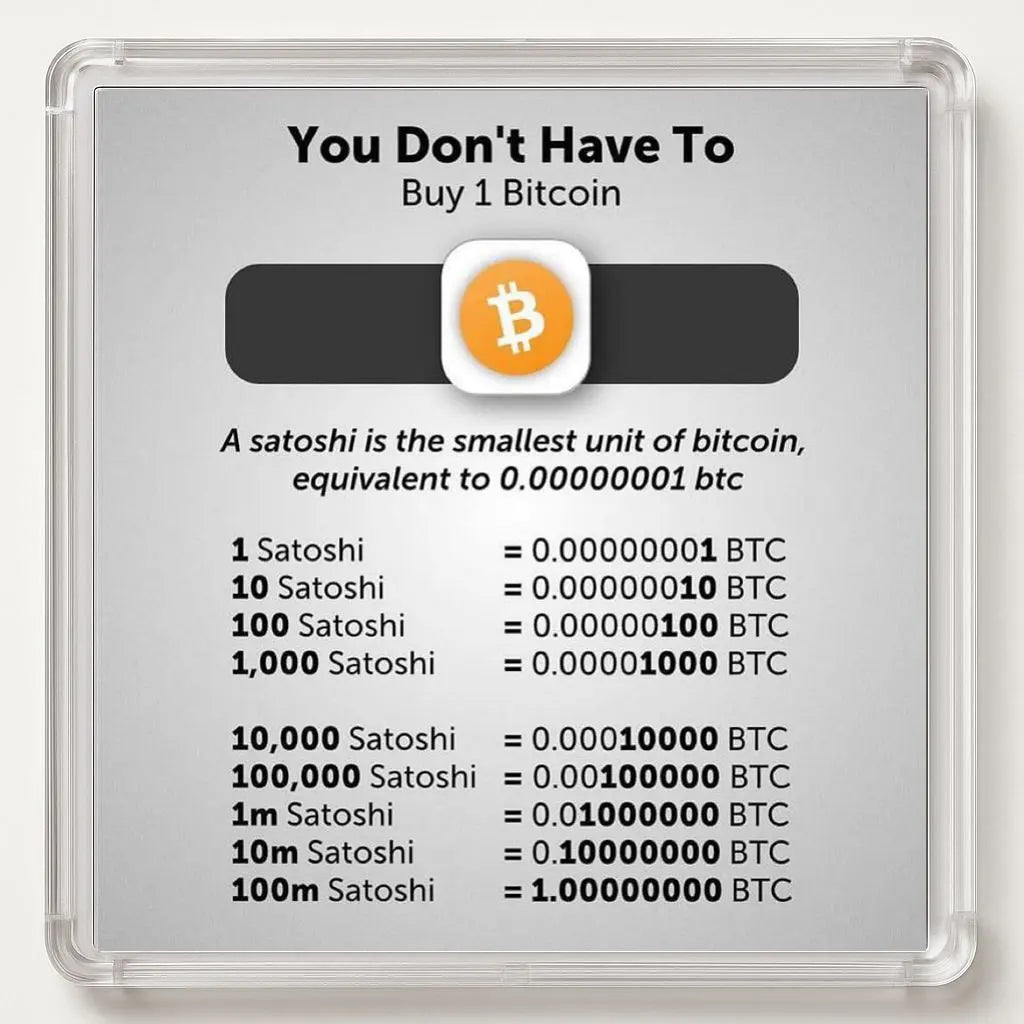
YOU DON'T NEED TO BUY A WHOLE BITCOIN
Share
Most people think Bitcoin has become unattainable. That the train has left. That it's too late. When they see a six-figure price in euros or dollars, they give up. They forget that Bitcoin is divisible into 100 million satoshis. They don't know that holding even 0.01 BTC could one day change their lives.
It's not so much a matter of having a whole bitcoin. It's a matter of time. Of understanding. Of strategy. And of courage. Because chances are you'll have to hurry. Time is against you. Not against Bitcoin. A simple calculation helps explain this. If the 21 million bitcoins were distributed equally to every human being on Earth, each would receive approximately 0.0025 BTC. But this hypothesis is a fairy tale. A significant portion of bitcoins is already lost. Another portion is locked forever in the treasuries of companies, governments, or long-term investors. Every day that passes makes Bitcoin scarcer. And every day that passes, you can buy a little less.
And yet, you can still accumulate. 100,000 satoshis is only a hundred euros. Even 10,000 satoshis is nothing today. But tomorrow? Tomorrow, it might be a plane ticket. A week's groceries. A month's rent. In a few years, it might be your retirement. Because Bitcoin is not just another asset. It's not a stock, nor a bond. It's a complete monetary system. Pure property. A value transfer technology beyond the control of banks, governments, and inflation. And above all, it's a finite asset. The first in history.
Michael Saylor understands this well. MicroStrategy is accumulating bitcoins week after week. No matter the price. No matter the volatility. Because there will be no second chances. They know. They act. While the general public still doubts, they are locking in their place in the future global monetary system. And they are not alone. Semler Scientific plans to acquire 105,000 bitcoins. MetaPlanet, Strike, 21 Capital, Nakamoto Corp… all are rushing to acquire the scarcest and most liquid asset ever created. They are not speculating. They are building.
Meanwhile, you have a window. A tiny window. You can still buy. You can still accumulate. All at once. Or in small monthly amounts. This is what we call DCA: regular purchasing, spread out over time. No matter your budget, what matters is consistency. And clear-headedness. Because in 2045, you won't be saying to yourself, "I should have waited." You'll be saying to yourself, "I should have started earlier."
A spreadsheet can help you project what you can accumulate. It takes into account inflation, the growth of your DCA, and the evolution of Bitcoin's estimated price according to the Saylor model. On average, a French person can save €240 per month. With this amount, you could accumulate less than 0.1 BTC by 2045. But that small 0.1 could be worth several hundred thousand euros in real purchasing power. And if you manage to invest early, all at once, you change the game. Buying now means getting many more satoshis than you would in five years. Or even six months.
Bitcoin is becoming increasingly rare. It's becoming more and more understood. It's becoming more and more desired. And it's becoming less and less accessible. What you can do today, you may not be able to do tomorrow. What you consider a small amount now could become colossal in a few years. You think you can't afford it? Start small. Start today. 100 sats, 1,000 sats, 10,000 sats. The important thing isn't the quantity. The important thing is to be in it. To be ready. And above all, to understand that you're not making an investment. You're freeing yourself. Regaining control. The euro is eroding. The dollar is collapsing. States are going into debt. Banks are becoming more fragile. Meanwhile, Bitcoin is progressing. Slowly. Inexorably. Day after day. Block after block. This is not a race for profit. It is a flight for survival.
You may not own a whole bitcoin. But you can own a fraction of the future. And that starts today.
👉 Also read:
- Why Bitcoin is a weapon against surveillance
- You don't own Bitcoin. It owns you.
- Did Satoshi predict the global currency war?
